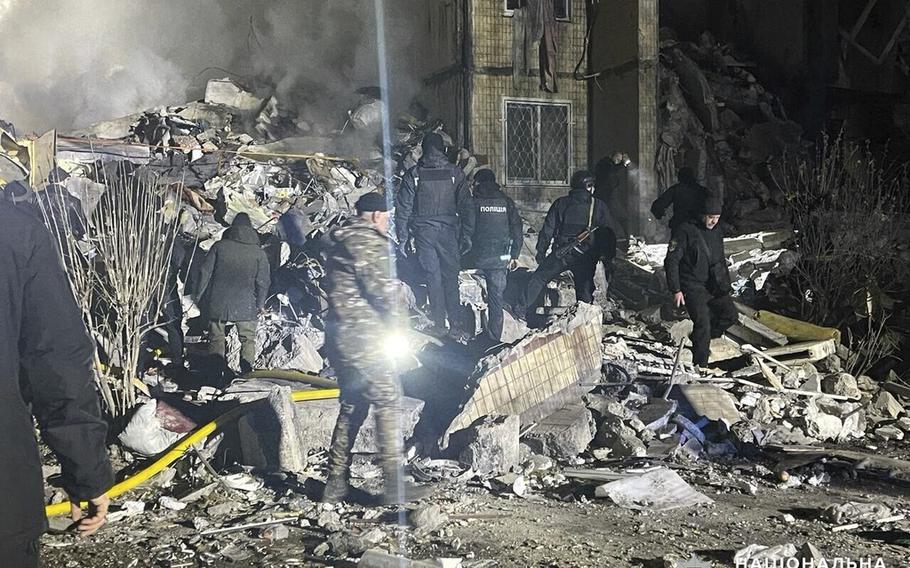
In this photo provided by the Ukrainian Police Press Office, emergency workers work on the site of a destroyed multi-store building after a Russian attack on residential neighborhood in Odesa, Ukraine, Saturday, March 2, 2024. (Ukrainian Police Press Office)
ODESA, Ukraine — March 15 was a normal, drizzly Friday. At 10 a.m., when a “double tap” attack of Russian Iskander-M missiles fired from Crimea hit the southern neighborhood of Dacha Kovalevskovo, my Odesite friends were busy with their regular daily stuff: Misha Reva, an artist, was at work on a sculpture in his atelier. Nika Viknianskiy, a furniture producer, was returning from a business trip to Kyiv. Sasha Babich, a historian, was mailing packages. In my home at Soborna Square, I was deep into an internet shopping spree.
Misha, Sasha and I, we all heard the two explosions. It was seven miles away, but Iskanders are huge and make a very loud noise — a sort of shoo-boom — and leave enormous craters. It’s not the more familiar paf-paf-paf of Shahed drones, which the defense systems manage to shoot down rather effectively. We quickly checked Telegram channels for the approximate location of the impact and instantly knew that all in our group were safe.
But at the site it was carnage: Some people were killed by the first impact, others who rushed to help were hit by a second missile landing in almost the same spot just 12 minutes later. The death toll was 21, with 75 wounded. Among the victims was a paramedic, two firefighters and a few police. I saw a photo of a corpse under a silver foil blanket — the fluorescent red trousers and jacket with reflective stripes identified this person as a samaritan, a civilian rescuer who paid with his life.
President Vladimir Putin launched the attack on the first day of Russia’s farcically misnamed presidential “election.” It might have not been intended symbolically. Perhaps it was just “one more”: the attack was the third major assault on Odesa in two weeks. On March 2, in the northern neighborhood of Peresyp, 12 people were killed by a Shahed drone, including five children. The apartment block now has this dollhouse look: with part of the building stripped away, you see the interior of the apartments. Four days later at the port, some 300 meters from where President Volodymyr Zelenskyy and visiting Greek Prime Minister Kyriakos Mitsotakis were getting into a car, a missile fired from occupied Crimea killed seven people.
What can normal mean in Odesa now? The day before this latest attack, I attended a conference. It was held in the cellar of a hotel. Not because people are afraid — when the air raid sirens sound, hardly anyone runs to shelters anymore. But the alarms are disruptive. Below ground, the conference could go on no matter what the Russians did.
Later that evening, at a friend’s house for drinks and dinner, we were reminded again of the war: We had to wrap up because the city — like the rest of Ukraine — is under curfew.
People here try to lead a normal life, but it is an imitation of normality. Take my friends: Misha has for the past two years been making sculptures from war debris, which — like Pablo Picasso’s “Guernica” — convey the horrors of war. Nika travels to Kyiv to help procure both drones and antidrone weapons, so crucial for the defense of Odesa. Sasha sends first aid kits to military units in Kherson, something every soldier needs that is all-too-frequently not provided by the Ministry of Defense. Me, I was online, ordering three excavators from a Polish company, to be used for trench digging — funded through a recently launched crowdsourcing campaign.
Odesa is everything Putin hates: It is modern, cosmopolitan, sophisticated, multiethnic. He claims it is “a Russian town,” yet he sends missiles to destroy it. Although the inhabitants are inured to the war, they are also defiant — almost provocatively so. Trying to lead a rich cultural life is a way of resisting what Ukrainians call “Ruscism” — a Russian version of fascism. This month, the opera house here is offering performances of Georges Bizet’s “Carmen,” Maurice Ravel’s “Boléro” and Carl Orff’s “Carmina Burana.” The Fine Arts Museum features the World Press Photo Exhibition 2023, where the picture of the year is of a pregnant woman on a watermelon-colored stretcher in Mariupol. The musical theater staged “Fiddler on the Roof,” sung in Russian with Ukrainian subtitles.
But defiance and art can only go so far. There is a new edginess in people as the attacks come more and more regularly. I can see it on the faces of my Odesite friends as they check the news about this war on their phones. They remain confident that Ukraine will prevail, hoping against all hope. But Putin’s impunity — with Western partners vacillating and Ukraine running out of men able to fight — hangs heavy over the city.
Anna Husarska is a journalist and political analyst.